Mechanical and Metallurgical Characterization of Nickel-Titanium Wire Types for Rotary Endodontic Instrument Manufacture
Abstract
1. Introduction
2. Materials and Methods
2.1. Microtensile Testing
- Mean values of the mechanical properties are not statistically significant for identical NiTi types at different temperatures.
- Mean values of the mechanical properties are not statistically significant for different NiTi types at identical temperatures.
2.2. Differential Scanning Calorimetry (DSC)
3. Results
3.1. Microtensile Testing
3.2. DSC Analysis
4. Discussion
5. Conclusions
- Behavior under tensile loading was influenced by NiTi alloy type and also by ambient temperature.
- Enhanced superelastic properties at body temperature could have relevance to improved clinical performance of newer NiTi alloy types.
Author Contributions
Funding
Institutional Review Board Statement
Informed Consent Statement
Acknowledgments
Conflicts of Interest
References
- Thompson, S.A. An overview of nickel-titanium alloys used in dentistry. Int. Endod. J. 2000, 33, 297–310. [Google Scholar] [CrossRef]
- Alapati, S.B.; Brantley, W.A.; Iijima, M.; Clark, W.A.; Kovarik, L.; Buie, C.; Liu, J.; Ben Johnson, W. Metallurgical characterization of a new nickel-titanium wire for rotary endodontic instruments. J. Endod. 2009, 35, 1589–1593. [Google Scholar] [CrossRef] [PubMed]
- Zupanc, J.; Vahdat-Pajouh, N.; Schäfer, E. New thermomechanically treated NiTi alloys—A review. Int. Endod. J. 2018, 51, 1088–1103. [Google Scholar] [CrossRef]
- Shen, Y.; Zhou, H.M.; Zheng, Y.F.; Peng, B.; Haapasalo, M. Current challenges and concepts of the thermomechanical treatment of nickel-titanium instruments. J. Endod. 2013, 39, 163–172. [Google Scholar] [CrossRef] [PubMed]
- Miyazaki, S.; Otsuka, K. Deformation and transition behavior associated with theR-phase in Ti-Ni alloys. Metall. Mater. Trans. A Phys. Metall. Mater. Sci. 1986, 17, 53–63. [Google Scholar] [CrossRef]
- Gambarini, G.; Grande, N.M.; Plotino, G.; Somma, F.; Garala, M.; De Luca, M.; Testarelli, L. Fatigue resistance of engine-driven rotary nickel-titanium instruments produced by new manufacturing methods. J. Endod. 2008, 34, 1003–1005. [Google Scholar] [CrossRef] [PubMed]
- Zhou, H.; Peng, B.; Zheng, Y.-F. An overview of the mechanical properties of nickel–titanium endodontic instruments. Endod. Top. 2013, 29, 42–54. [Google Scholar] [CrossRef]
- Shen, Y.; Zhou, H.-M.; Wang, Z.; Campbell, L.; Zheng, Y.-F.; Haapasalo, M. Phase transformation behavior and mechanical properties of thermomechanically treated K3XF nickel-titanium instruments. J. Endod. 2013, 39, 919–923. [Google Scholar] [CrossRef] [PubMed]
- Miyazaki, S.; Otsuka, K.; Suzuki, Y. Transformation pseudoelasticity and deformation behavior in a Ti-50.6at%Ni alloy. Scr. Metall. 1981, 15, 287–292. [Google Scholar] [CrossRef]
- ASTM E8/E8M-21; Standard Test Methods for Tension Testing of Metallic Materials. ASTM International: West Conshohocken, PA, USA, 2021. Available online: www.astm.org (accessed on 26 October 2022).
- De Vasconcelos, R.A.; Murphy, S.; Carvalho, C.A.; Govindjee, R.G.; Govindjee, S.; Peters, O.A. Evidence for reduced fatigue resistance of contemporary rotary instruments exposed to body temperature. J. Endod. 2016, 42, 782–787. [Google Scholar] [CrossRef]
- Shen, Y.; Zhou, H.M.; Zheng, Y.F.; Campbell, L.; Peng, B.; Haapasalo, M. Metallurgical characterization of controlled memory wire nickel-titanium rotary instruments. J. Endod. 2011, 37, 1566–1571. [Google Scholar] [CrossRef] [PubMed]
- Yahata, Y.; Yoneyama, T.; Hayashi, Y.; Ebihara, A.; Doi, H.; Hanawa, T.; Suda, H. Effect of heat treatment on transformation temperatures and bending properties of nickel-titaniu.um endodontic instruments. Int. Endod. J. 2009, 42, 621–626. [Google Scholar] [CrossRef]
- Hülsmann, M. Research that matters: Studies on fatigue of rotary and reciprocating NiTi root canal instruments. Int. Endod. J. 2019, 52, 1401–1402. [Google Scholar] [CrossRef] [PubMed]
- Silva, E.J.N.L.; Martins, J.N.; Lima, C.O.; Vieira, V.T.L.; Fernandes, F.M.B.; De-Deus, G.; Versiani, M.A. Mechanical tests, metallurgical characterization, and shaping ability of nickel-titanium rotary instruments: A multimethod research. J. Endod. 2020, 46, 1485–1494. [Google Scholar] [CrossRef] [PubMed]
- Tsujimoto, M.; Irifune, Y.; Tsujimoto, Y.; Yamada, S.; Watanabe, I.; Hayashi, Y. Comparison of conventional and new-generation nickel-titanium files in regard to their physical properties. J. Endod. 2014, 40, 1824–1829. [Google Scholar] [CrossRef]
- Shim, K.S.; Oh, S.; Kum, K.; Kim, Y.C.; Jee, K.K.; Chang, S.W. Mechanical and metallurgical properties of various nickel-titanium rotary instruments. Biomed. Res. Int. 2017, 2017, 4528601. [Google Scholar] [CrossRef]
- Oh, S.; Kum, K.-Y.; Kim, H.-J.; Moon, S.-Y.; Kim, H.-C.; Chaniotis, A.; Perinpanayagam, H.; Pedullá, E.; Chang, S.W. Bending resistance and cyclic fatigue resistance of WaveOne Gold, Reciproc Blue, and HyFlex EDM instruments. J. Dent. Sci. 2020, 15, 472–478. [Google Scholar] [CrossRef]
- Scott, R.; Arias, A.; Macorra, J.C.; Govindjee, S.; Peters, O.A. Resistance to cyclic fatigue of reciprocating instruments determined at body temperature and phase transformation analysis. Aust. Endod. J. 2019, 45, 400–406. [Google Scholar] [CrossRef] [PubMed]
- Arias, A.; Hejlawy, S.; Murphy, S.; de la Macorra, J.C.; Govindjee, S.; Peters, O.A. Variable impact by ambient temperature on fatigue resistance of heat-treated nickel titanium instruments. Clin. Oral Investig. 2019, 23, 1101–1108. [Google Scholar] [CrossRef]
- Shen, Y.; Zhou, H.; Coil, J.M.; Aljazaeri, B.; Buttar, R.; Wang, Z.; Zheng, Y.-F.; Haapasalo, M. ProFile Vortex and Vortex Blue nickel-titanium rotary instruments after clinical use. J. Endod. 2015, 41, 937–942. [Google Scholar] [CrossRef]
- Roberto-Pereira, F.F. Extraction of Superelastic Parameter Values from Instrumented Indentation Data. Ph.D. Thesis, University of Cambridge, Cambridge, UK, 2019. [Google Scholar]
- Kato, H.; Sasaki, K. Avoiding error of determining the martensite finish temperature due to thermal inertia in differential scanning calorimetry: Model and experiment of Ni–Ti and Cu–Al–Ni shape memory alloys. J. Mater. Sci. 2012, 47, 1399–1410. [Google Scholar] [CrossRef]
- Pereira, E.S.; Gomes, R.O.; Leroy, A.M.; Singh, R.; Peters, O.A.; Bahia, M.G.; Buono, V.T. Mechanical behavior of M-Wire and conventional NiTi wire used to manufacture rotary endodontic instruments. Dent. Mater. 2013, 29, e318–e324. [Google Scholar] [CrossRef] [PubMed]
- Naceur, I.B.; Charfi, A.; Bouraoui, T.; Elleuch, K. Finite element modeling of superelastic nickel-titanium orthodontic wires. J. Biomech. 2014, 47, 3630–3638. [Google Scholar] [CrossRef] [PubMed]
- ASTM F2516-22; Standard Test Method for Tension Testing of Nickel-Titanium Superelastic Materials. ASTM International: West Conshohocken, PA, USA, 2022. Available online: www.astm.org (accessed on 26 October 2022).
- Barsoum, R. Chapter 10—The interaction of high strain-rate elastomeric polymer coating with the substrate material and the mechanisms of failure. In Elastomeric Polymers with High Rate Sensitivity; Barsoum, R.G., Ed.; William Andrew Publishing: Oxford, UK, 2015; pp. 346–401. [Google Scholar]
- Duncan, B. Chapter 14—Developments in testing adhesive joints. In Advances in Structural Adhesive Bonding; Dillard, D.A., Ed.; Woodhead Publishing: Sawston, UK, 2010; pp. 389–436. [Google Scholar]

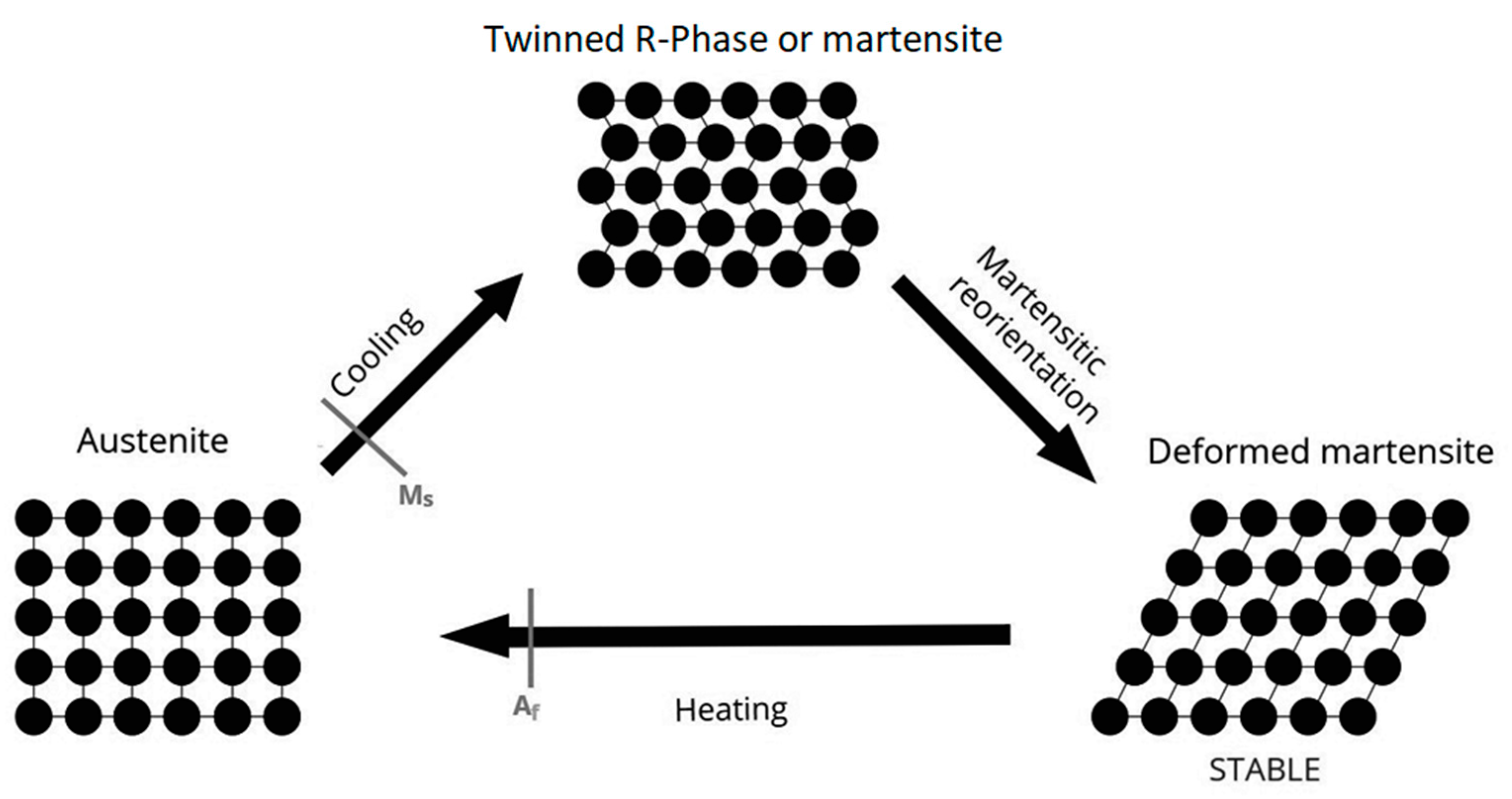
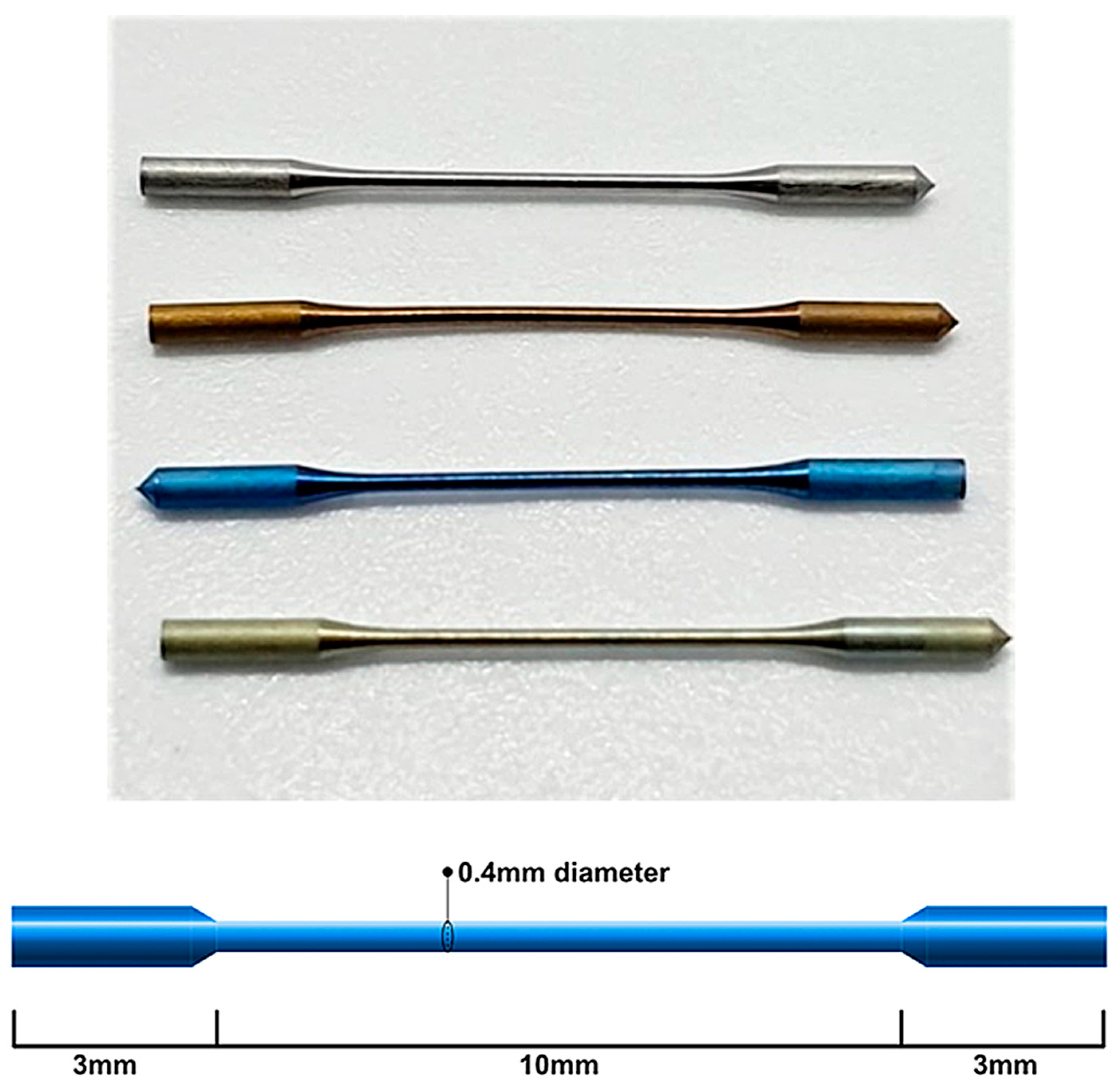

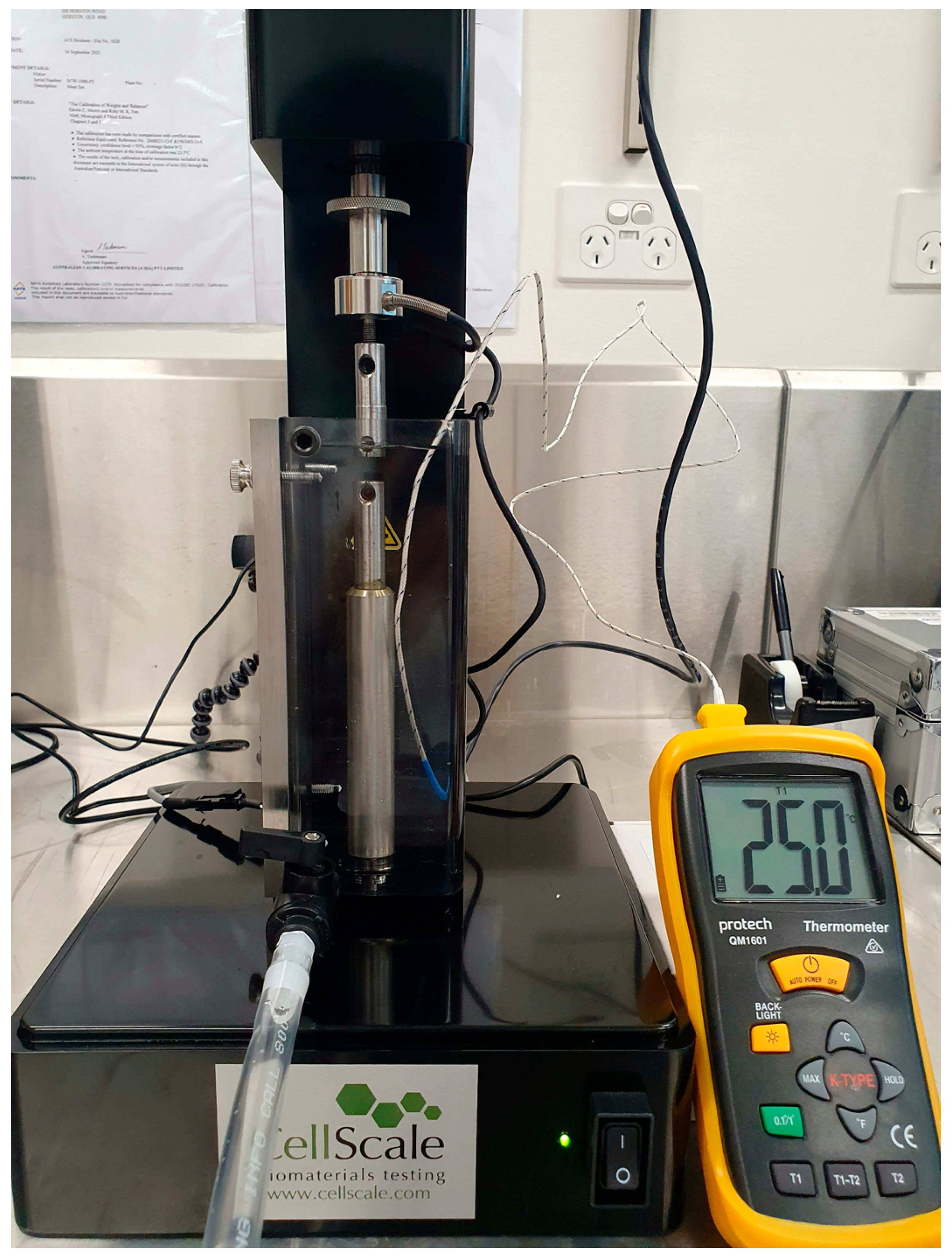
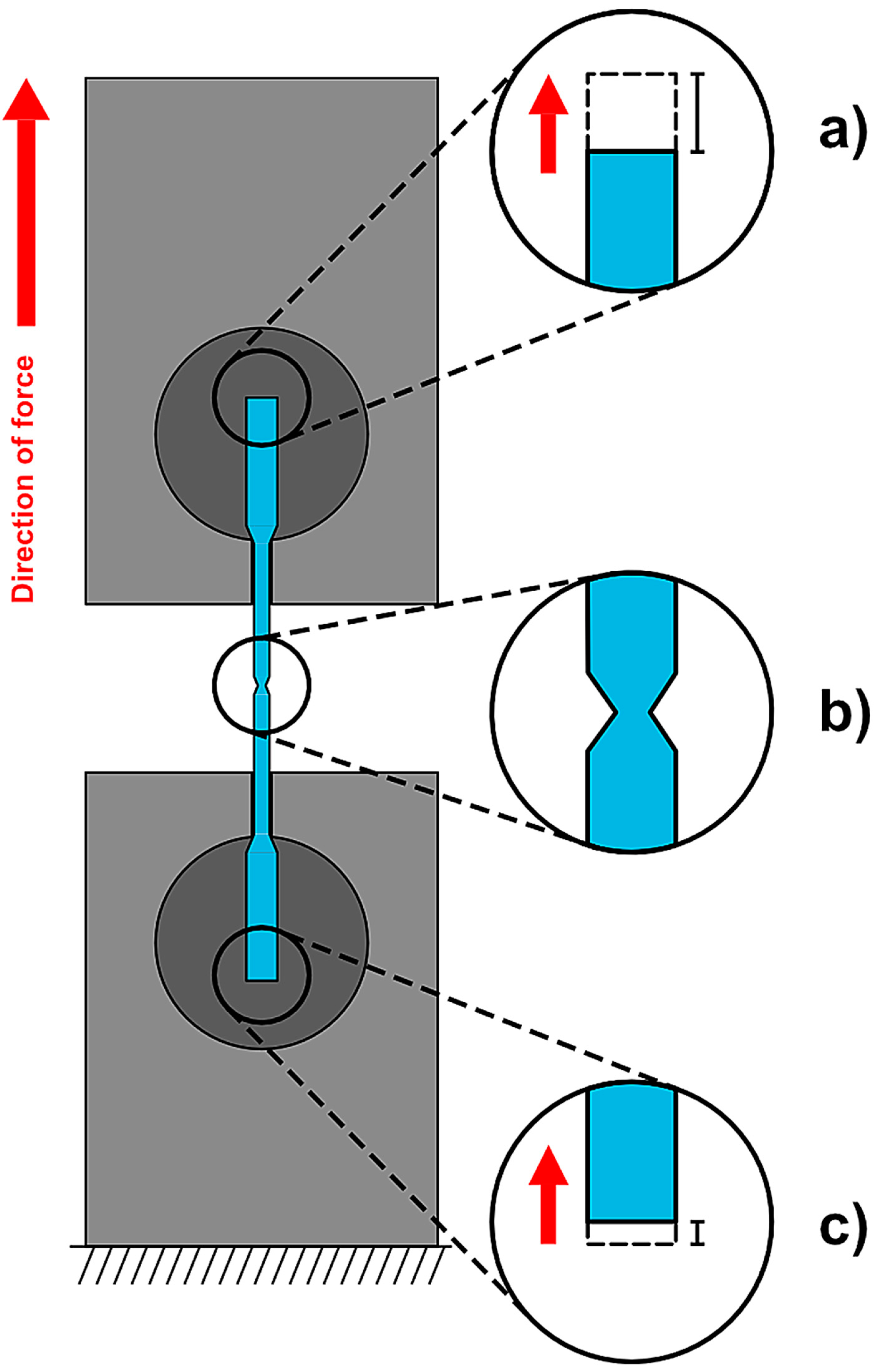
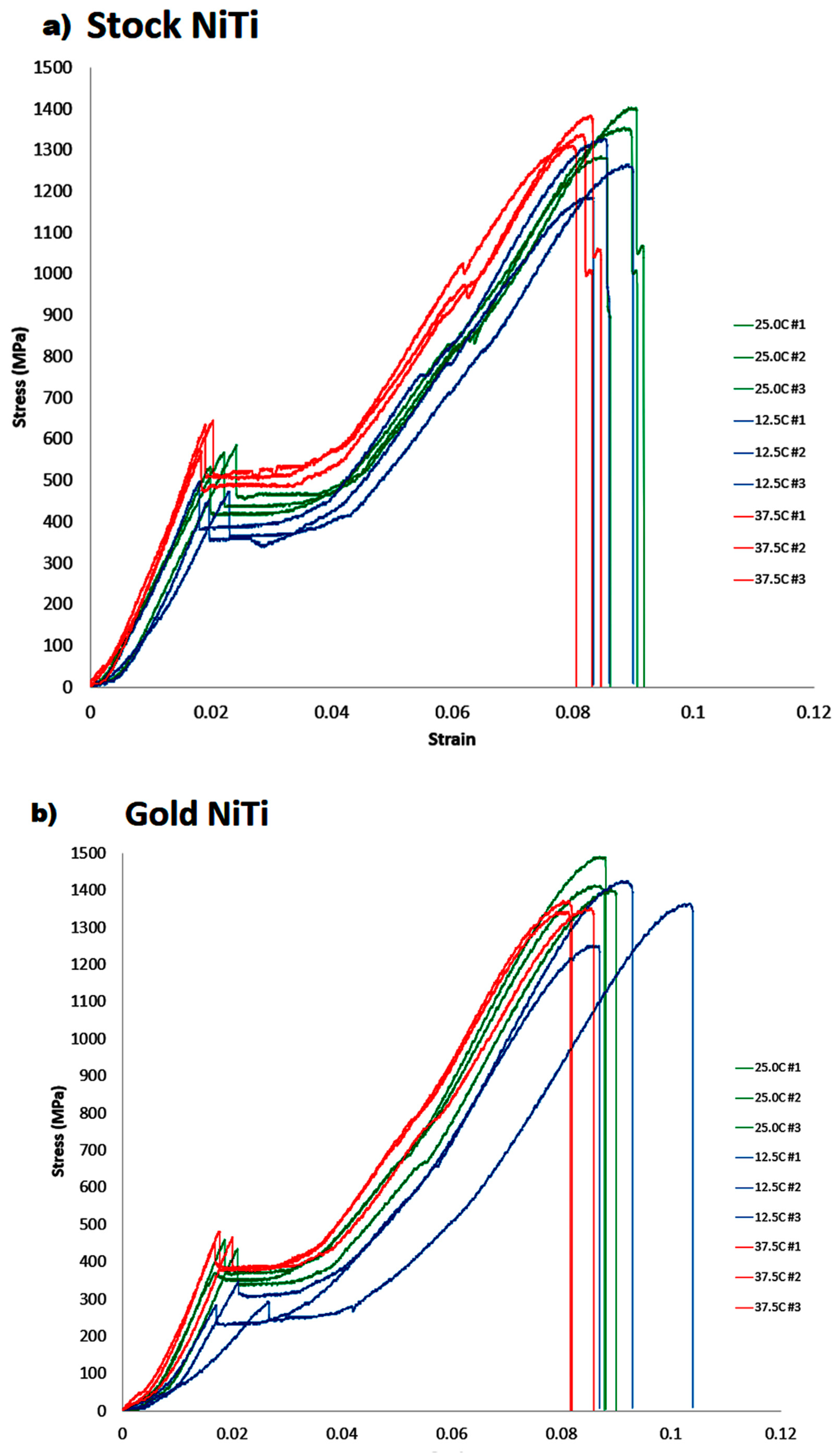
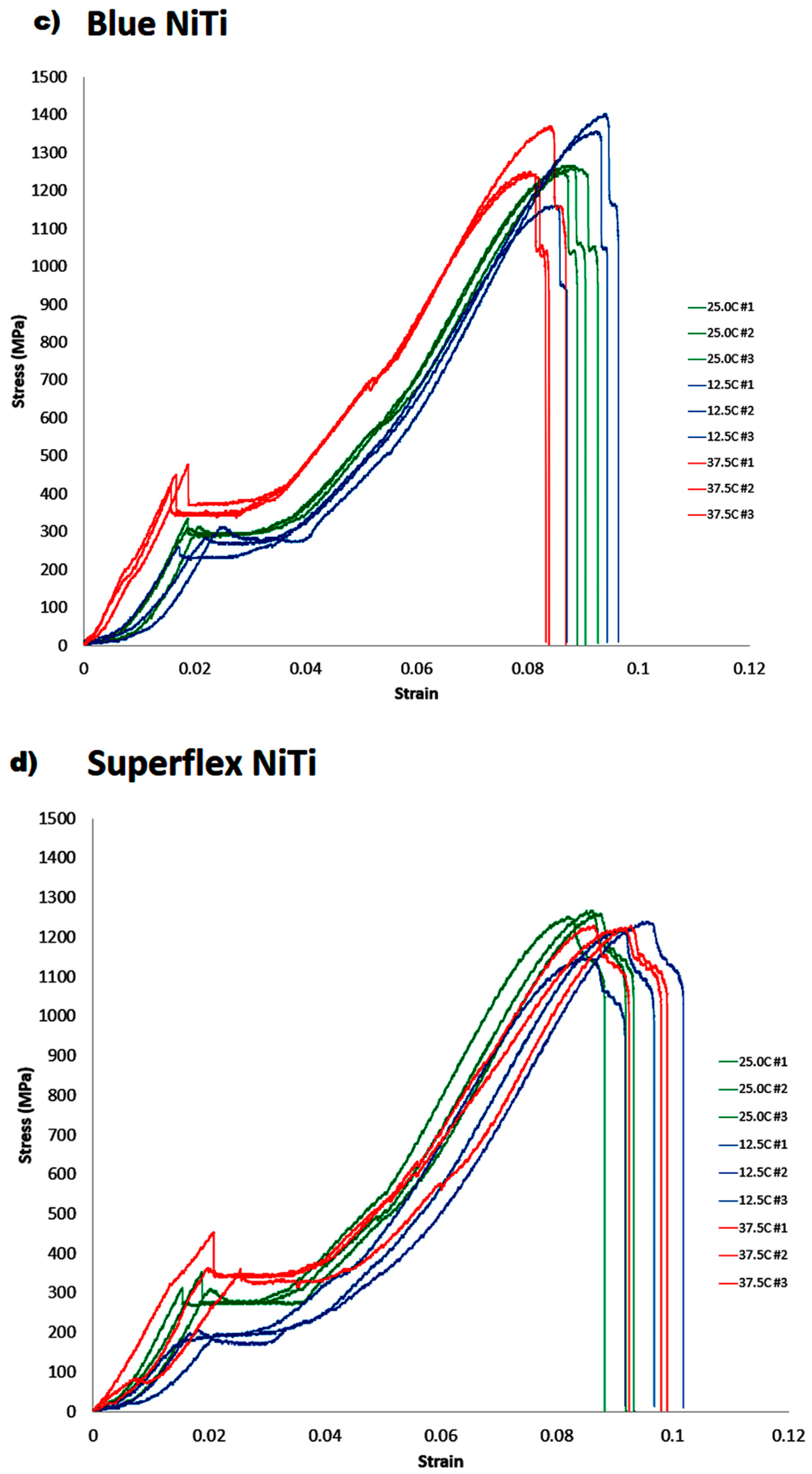
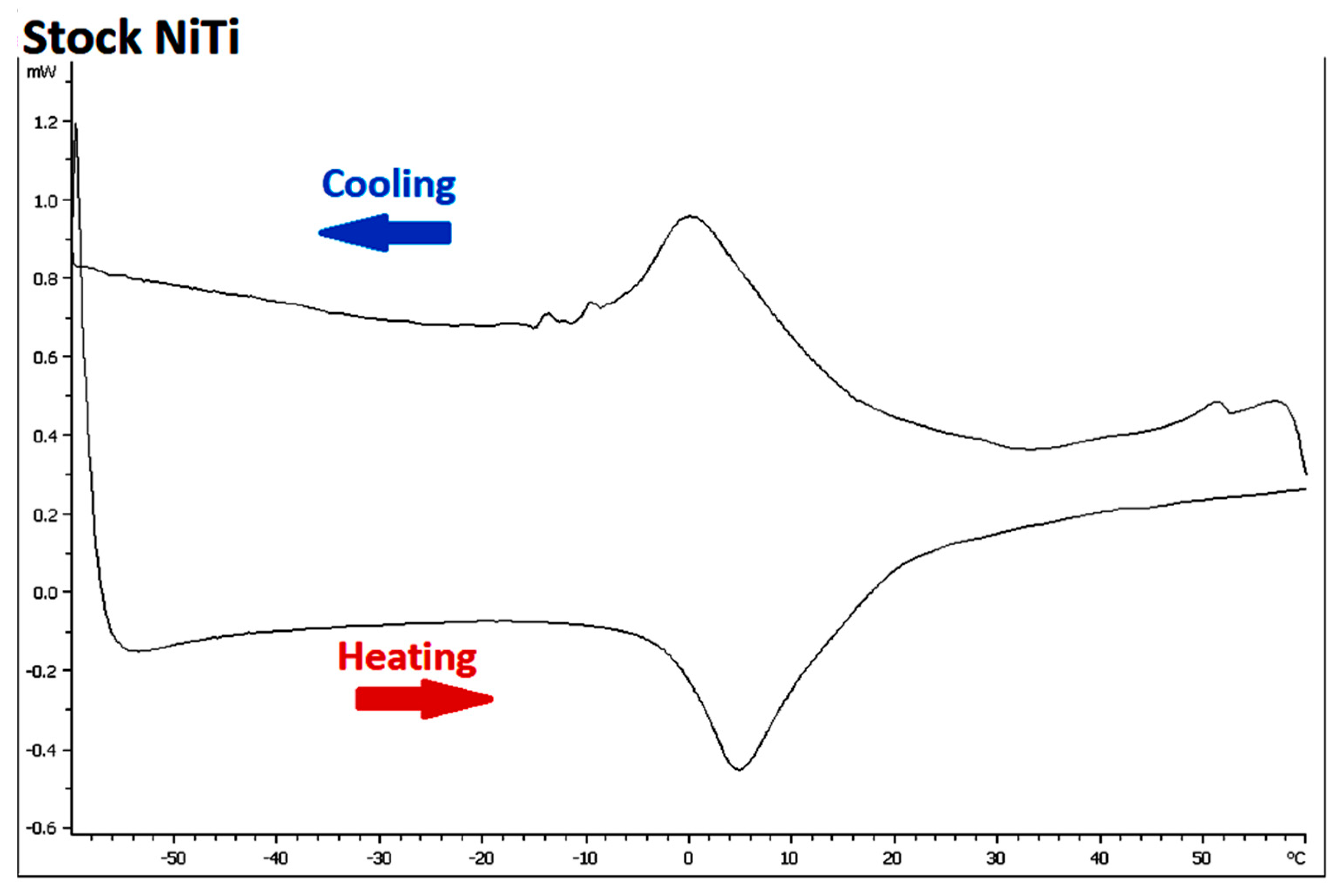
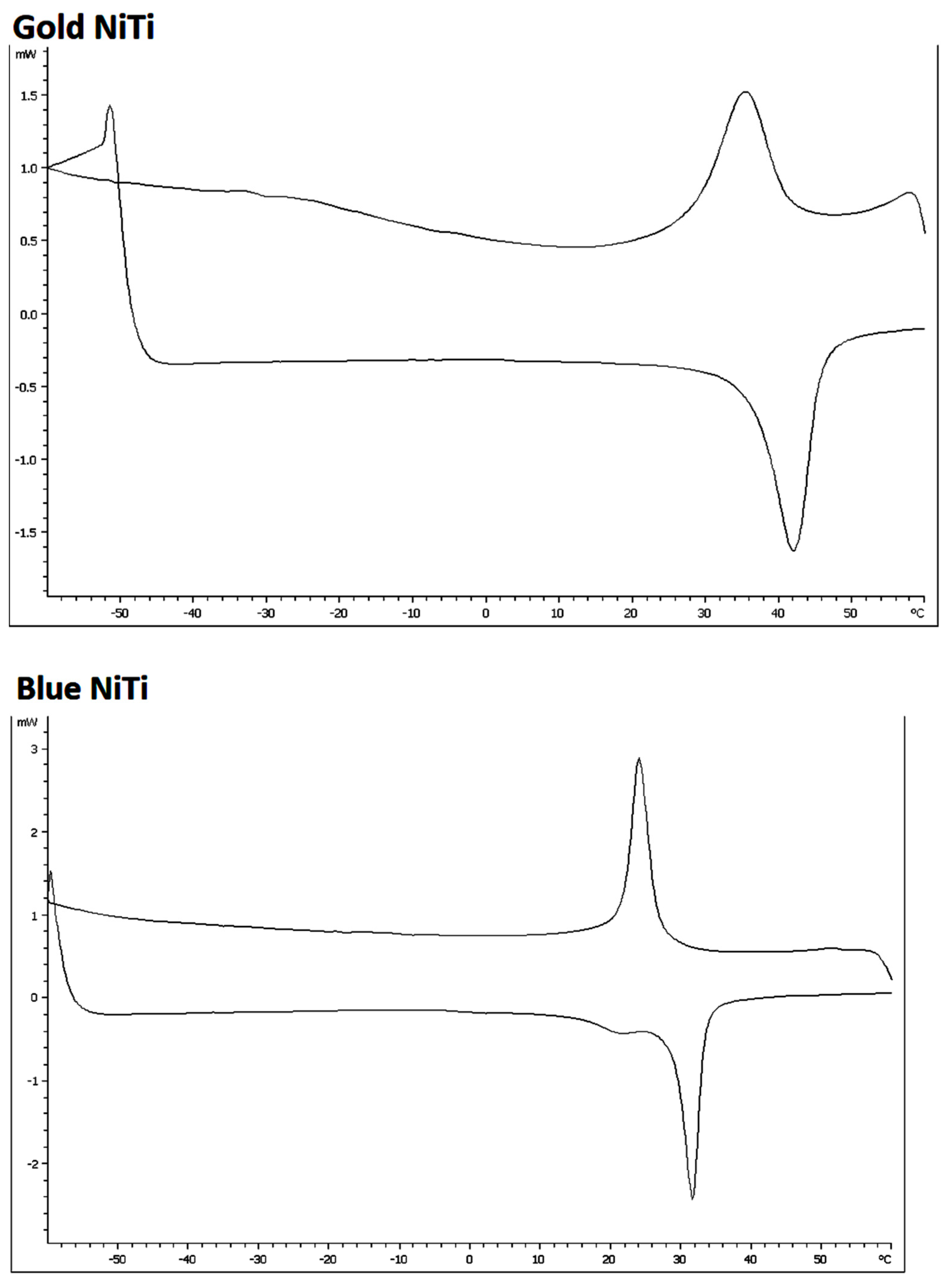
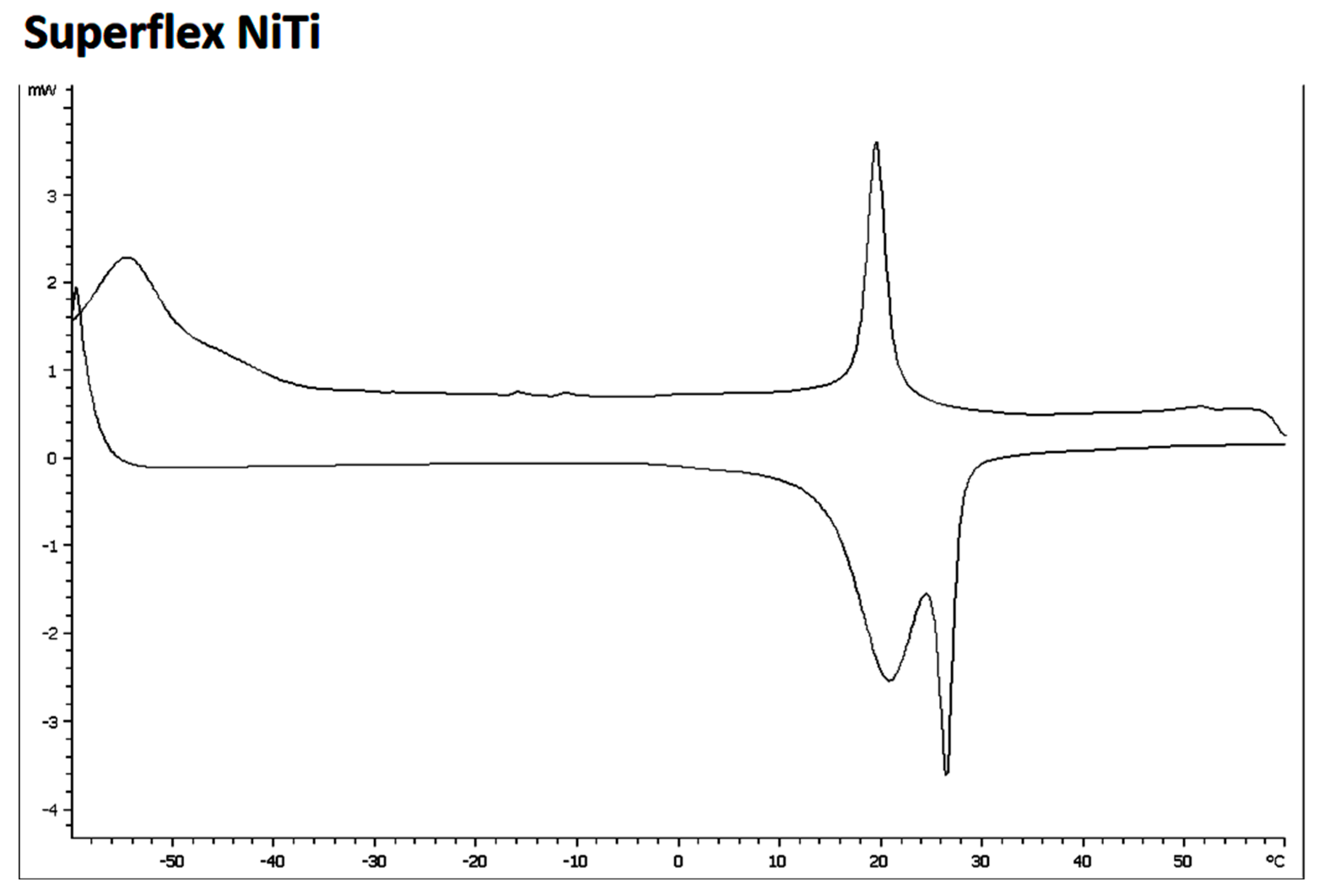
| NiTi Type | Corresponding Dentsply Instrument |
|---|---|
| Stock | ProTaper UniversalTM |
| Gold | ProTaper Gold, WaveOne Gold, ProTaper UltimateTM |
| Blue | Vortex Blue, ProTaper UltimateTM |
| Superflex | TruNatomyTM |
| NiTi | Temperature (°C) | Ea (MPa) 1 | Em (MPa) 2 | εmax (%) 3 | σA-M (MPa) 4 | σmax (MPa) 5 |
|---|---|---|---|---|---|---|
| Stock | 12.5 | 27,672 ± 4155 | 19,731 ± 1048 | 4.2 ± 0.3 | 473.7 ± 22.1 | 1258.0 ± 72.2 |
| 25 | 28,248 ± 1806 | 20,146 ± 470 | 4.5 ± 0.3 | 561.8 ± 25.8 | 1343.9 ± 60.9 | |
| 37.5 | 35,155 ± 1498 | 20,760 ± 505 | 4.3 ± 0.1 | 617.1 ± 40.5 | 1344.2 ± 37.1 | |
| Gold | 12.5 | 21,135 ± 3461 | 21,657 ± 3107 | 4.0 ± 0.6 | 308.3 ± 34.9 | 1346.2 ± 87.4 |
| 25 | 30,573 ± 1891 | 21,254 ± 444 | 3.8 ± 0.2 | 420.6 ± 47.8 | 1435.6 ± 47.2 | |
| 37.5 | 33,061± 3597 | 22,001 ± 766 | 3.8 ± 0.1 | 464.6 ± 16.9 | 1354.7 ± 15.5 | |
| Blue | 12.5 | 21,645 ± 1757 | 21,154 ± 931 | 3.9 ± 0.2 | 279.0 ± 16.4 | 1291.4 ± 121.9 |
| 25 | 28,673 ± 1444 | 20,900 ± 485 | 3.9 ± 0.2 | 314.1 ± 19.8 | 1238.0 ± 6.7 | |
| 37.5 | 29,880 ± 4932 | 19,988 ± 702 | 3.5 ± 0.2 | 448.2 ± 31.1 | 1286.2 ± 68.8 | |
| Superflex | 12.5 | 18,527 ± 1751 | 20,376 ± 1577 | 3.5 ± 0.3 | 203.0 ± 0.9 | 1201.6 ± 46.4 |
| 25 | 26,580 ± 1060 | 21,029 ± 594 | 3.6 ± 0.2 | 326.0 ± 23.8 | 1258.7 ± 6.7 | |
| 37.5 | 24,395 ± 3896 | 19,251 ± 1346 | 3.8 ± 0.3 | 388.0 ± 58.2 | 1223.5 ± 6.2 |
| NiTi | Temperature (°C) | Ea (MPa) 1 | Em (MPa) 2 | εmax (%) 3 | σA-M (MPa) 4 | σmax (MPa) 5 |
|---|---|---|---|---|---|---|
| Stock | 12.5 vs. 25.0 | ns | ns | ns | p = 0.0066 ** | ns |
| 12.5 vs. 37.5 | p = 0.011 * | ns | ns | p < 0.0001 **** | ns | |
| 25.0 vs. 37.5 | p = 0.0193 * | ns | ns | ns | ns | |
| Gold | 12.5 vs. 25.0 | p = 0.0015 ** | ns | ns | p = 0.0007 *** | ns |
| 12.5 vs. 37.5 | p = 0.0001 *** | ns | ns | p < 0.001 **** | ns | |
| 25.0 vs. 37.5 | ns | ns | ns | ns | ns | |
| Blue | 12.5 vs. 25.0 | p = 0.0172 * | ns | ns | ns | ns |
| 12.5 vs. 37.5 | p = 0.0051 ** | ns | ns | p < 0.0001 **** | ns | |
| 25.0 vs. 37.5 | ns | ns | ns | p < 0.0001 **** | ns | |
| Superflex | 12.5 vs. 25.0 | p = 0.0062 ** | ns | ns | p = 0.0002 | ns |
| 12.5 vs. 37.5 | ns | ns | ns | p < 0.0001 **** | ns | |
| 25.0 vs. 37.5 | ns | ns | ns | ns | ns |
| Temperature (°C) | NiTi | Ea (MPa) 1 | Em (MPa) 2 | εmax (%) 3 | σA-M (MPa) 4 | σmax (MPa) 5 |
|---|---|---|---|---|---|---|
| 12.5 | Stock vs. Gold | p = 0.0485 * | ns | ns | p < 0.0001 **** | ns |
| Stock vs. Blue | ns | ns | ns | p < 0.0001 **** | ns | |
| Stock vs. Superflex | p = 0.0037 ** | n | p = 0.0270 * | p < 0.0001 **** | ns | |
| Gold vs. Blue | ns | ns | ns | ns | ns | |
| Gold vs. Superflex | ns | ns | ns | p = 0.0024 ** | p = 0.0308 * | |
| Blue vs. Superflex | ns | ns | ns | p = 0.00350 * | ns | |
| 25 | Stock vs. Gold | ns | ns | p = 0.0261 * | p < 0.0001 **** | ns |
| Stock vs. Blue | ns | ns | ns | p < 0.0001 **** | ns | |
| Stock vs. Superflex | ns | ns | p = 0.0030 * | p < 0.0001 **** | ns | |
| Gold vs. Blue | ns | ns | ns | p = 0.0022 ** | p = 0.0063 ** | |
| Gold vs. Superflex | ns | ns | ns | p = 0.0067 ** | p = 0.0065 ** | |
| Blue vs. Superflex | ns | ns | ns | ns | ns | |
| 37.5 | Stock vs. Gold | ns | ns | ns | p < 0.0001 **** | ns |
| Stock vs. Blue | ns | ns | p = 0.0064 ** | p < 0.0001 **** | ns | |
| Stock vs. Superflex | p = 0.0007 *** | ns | ns | p < 0.0001 **** | ns | |
| Gold vs. Blue | ns | ns | ns | ns | ns | |
| Gold vs. Superflex | p = 0.0061 ** | ns | ns | p = 0.0332 | ns | |
| Blue vs. Superflex | ns | ns | ns | ns | ns |
| NiTi Type | Ms (°C) 1 | Mf (°C) 2 | As (°C) 3 | Af (°C) 4 |
|---|---|---|---|---|
| Stock | 13.0 ± 0.2 | −7.6 ± 1.8 | −3.0 ± 0.2 | 15.9 ± 0.5 |
| Gold | 41.4 ± 0.1 | 29.8 ± 1.2 | 36.3 ± 0.2 | 46.0 ± 0.2 |
| Blue | 27.2 ± 0.4 | 23.2 ± 1.5 | 29.3 ± 0.4 | 33.4 ± 0.1 |
| Superflex | 20.9 ± 1.1 | 17.5 ± 0.2 | 24.3 ± 0.1 | 28.2 ± 0.2 |
Publisher’s Note: MDPI stays neutral with regard to jurisdictional claims in published maps and institutional affiliations. |
© 2022 by the authors. Licensee MDPI, Basel, Switzerland. This article is an open access article distributed under the terms and conditions of the Creative Commons Attribution (CC BY) license (https://creativecommons.org/licenses/by/4.0/).
Share and Cite
Chien, P.Y.-H.; Martins, J.N.R.; Walsh, L.J.; Peters, O.A. Mechanical and Metallurgical Characterization of Nickel-Titanium Wire Types for Rotary Endodontic Instrument Manufacture. Materials 2022, 15, 8367. https://doi.org/10.3390/ma15238367
Chien PY-H, Martins JNR, Walsh LJ, Peters OA. Mechanical and Metallurgical Characterization of Nickel-Titanium Wire Types for Rotary Endodontic Instrument Manufacture. Materials. 2022; 15(23):8367. https://doi.org/10.3390/ma15238367
Chicago/Turabian StyleChien, Philip Y-H., Jorge N. R. Martins, Laurence J. Walsh, and Ove A. Peters. 2022. "Mechanical and Metallurgical Characterization of Nickel-Titanium Wire Types for Rotary Endodontic Instrument Manufacture" Materials 15, no. 23: 8367. https://doi.org/10.3390/ma15238367
APA StyleChien, P. Y.-H., Martins, J. N. R., Walsh, L. J., & Peters, O. A. (2022). Mechanical and Metallurgical Characterization of Nickel-Titanium Wire Types for Rotary Endodontic Instrument Manufacture. Materials, 15(23), 8367. https://doi.org/10.3390/ma15238367









